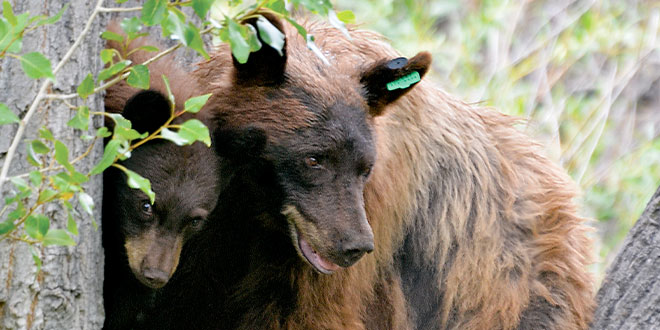Finding a needle in a haystack might sound like a difficult, painstaking process, but it pales in comparison to estimating the number of bears on the landscape.
Wildlife agencies across the nation face a notoriously difficult challenge trying to estimate bear populations, but new methods offer the ability to more accurately estimate bear numbers than ever before.
“You can’t do a helicopter survey like you would with deer or elk. It would be ineffective,” said Rick Winslow, bear and cougar biologist for the New Mexico Department of Game and Fish. “They occur in fairly low densities and they’re spread out over the available habitat.”
The last study occurred over 15 years ago, but novel methods provide the means to estimate an accurate, reliable, scientifically-based minimum head count for bears.
But it was far from simple. The non-invasive research included hair traps, bear rubs and putting a good pair of hiking boots to the test.
Hair traps were set with a single strand of barbed wire wrapped around three or more trees at about knee height with a lure pile. The smells from the lure piles attracted the bears, which would go under or over the strand to investigate, snagging hairs from the animal.
The team also took advantage of a bear’s natural behavior of rubbing on objects. After identifying rubbing sites, a strand of barbed wire was wrapped around the item – such as a tree, telephone pole, or sign post – to collect hair.
The hairs were sent to Wildlife Genetics International in British Columbia for DNA analysis. By collecting DNA, individual bears roaming a specific territory could be identified. Samples degraded by ultraviolet radiation likely reduced the number of individual and recaptured bears identified in the study.
“The attractants used with the hair traps involved materials that provided no caloric value, such as skunk essence, to avoid getting bears habituated to human foods,” Winslow said.
“There was no chance to injure bears,” said Matt Gould, Ph.D. student with the New Mexico State University Department of Biology. “They regularly cross barbed-wire fences. These traps have been used for years.”
Gould and other New Mexico State University personnel were contracted by Game and Fish to conduct the study.
“Not at all easy,” Gould said of the work. “It involved a lot of hiking because each trap was roughly three miles apart.”
The study took three years and involved primary bear habitat in five study areas in three mountain ranges; the northern and southern Sangre de Cristo Mountains, the Sandia Mountains, and the northern and southern Sacramento Mountains.
“All the areas studied were identified as primary bear habitat,” Winslow said.
There are three levels of bear habitat: primary, secondary and edge.
“Only the primary is studied because the others generally only provide supplementary resources,” Winslow said. “They mostly use those areas to forage on specific foods, such as piñon nuts or juniper berries or for travel from place-to-place.”
In all, the team of researchers monitored 554 hair traps, documented 117 bear rubs and collected 4,083 hair samples.
Following all the hiking and DNA testing, turns out the decade-old density study was comparable with the most recent findings.
“Bears are at similar or higher densities than what New Mexico has been managing for based on previous studies,” Gould said. “Our study was specific to density and I’m confident we produced results similar to the rest of the United States.”
Bear density provides the means to estimate an overall population by applying density to the total area of primary, occupied habitat. Using a combination of density information from the new and older studies, Winslow concluded New Mexico’s black bear population is 8,000-9,000.
“We have a high level of confidence the bear population is reliably estimated at this time,” Winslow said. “The study covered about half of the primary bear habitat in the state. This is the best we can do as an agency to come up with the best possible bear population estimate.
“It was an extensive study. The whole study last-ed three seasons, one season in each mountain range, except the Sandia range, where a second effort was conducted using volunteers to collect data.”
The proximity to Albuquerque was the reason for a closer look at the Sandia Mountains.
“There’s a lot of public and media curiosity for that area,” Winslow said.
The scientific study will allow Game and Fish to better manage bear populations throughout New Mexico.
“Having a report like this provides the means to scientifically manage New Mexico’s bear populations using the best information available,” Winslow said. “Our ultimate goal is to maintain long-term viable wildlife populations with sustainable harvest.”
 New Mexico Wildlife magazine Conserving New Mexico's Wildlife for Future Generations
New Mexico Wildlife magazine Conserving New Mexico's Wildlife for Future Generations
